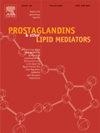LPS通过PGE2形成和EP4信号传导调控M1-和m2样巨噬细胞的吞噬作用。
IF 2.5
3区 生物学
Q3 BIOCHEMISTRY & MOLECULAR BIOLOGY
Prostaglandins & other lipid mediators
Pub Date : 2025-05-16
DOI:10.1016/j.prostaglandins.2025.106998
引用次数: 0
摘要
吞噬作用是人体先天免疫应答的一个关键过程。人类巨噬细胞是吞噬和中和病原体和细胞碎片的重要吞噬细胞。此外,它们通过释放细胞因子和脂质介质来调节炎症过程。然而,在不同巨噬细胞表型中,氧脂素和吞噬作用之间的联系仍然知之甚少。为了更好地理解吞噬与花生四烯酸(ARA)级联之间的联系,我们在来自外周血单核细胞(PBMC)的原发性人“炎症”M1-和“抗炎”m2样巨噬细胞中建立了吞噬实验,这些巨噬细胞代表了巨噬细胞的极端表型。通过定量靶向蛋白质组学和代谢组学对ARA级联分支进行了研究。与m2样巨噬细胞相比,m1样巨噬细胞在LPS刺激后表现出更高的环氧化酶(COX)-2及其产物丰度。LPS增加了m2样巨噬细胞的吞噬能力,但对m1样巨噬细胞没有影响。我们证明COX产物前列腺素E2 (PGE2)调节LPS对吞噬的不同影响:通过EP4受体,PGE2信号传导抑制原代人巨噬细胞的吞噬。因此,阻断COX,例如使用非甾体抗炎药(NSAID),也会导致“炎性”m1样巨噬细胞的吞噬能力增加。这支持了这些药物良好的抗炎作用,并强调了ARA级联的COX分支与人类巨噬细胞吞噬调节之间联系的重要性。本文章由计算机程序翻译,如有差异,请以英文原文为准。
Phagocytosis is differentially regulated by LPS in M1- and M2-like macrophages via PGE2 formation and EP4 signaling
Phagocytosis is a key process in human innate immune response. Human macrophages are important phagocytes engulfing and neutralizing pathogens and cell debris. In addition, they modulate the inflammatory process by releasing cytokines and lipid mediators. However, the link between oxylipins and phagocytosis in different macrophage phenotypes remains poorly understood. In order to better understand the link between phagocytosis and the arachidonic acid (ARA) cascade, we established a phagocytosis assay in primary human ‘inflammatory’ M1- and ‘anti-inflammatory’ M2-like macrophages from peripheral blood mononuclear cells (PBMC), representing extremes of macrophage phenotypes. The branches of the ARA cascade were investigated by quantitative targeted proteomics and metabolomics. M1-like macrophages show a higher abundance of cyclooxygenase (COX)-2 and its products particularly after LPS stimulus compared to M2-like macrophages. LPS increased phagocytosis in M2-like, but not in M1-like macrophages. We demonstrate that the COX product prostaglandin E2 (PGE2) modulates the differential effects of LPS on phagocytosis: Via the EP4 receptor PGE2 signaling suppresses phagocytosis in primary human macrophages. Thus, blockage of COX, e.g. by non-steroidal anti-inflammatory drugs (NSAID), leads to an increase of phagocytosis also in ‘inflammatory’ M1-like macrophages. This supports the well-described anti-inflammatory effects of these drugs and underscores the importance of the link between the COX branch of the ARA cascade and the regulation of phagocytosis in human macrophages.
求助全文
通过发布文献求助,成功后即可免费获取论文全文。
去求助
来源期刊

Prostaglandins & other lipid mediators
生物-生化与分子生物学
CiteScore
5.80
自引率
3.40%
发文量
49
审稿时长
2 months
期刊介绍:
Prostaglandins & Other Lipid Mediators is the original and foremost journal dealing with prostaglandins and related lipid mediator substances. It includes basic and clinical studies related to the pharmacology, physiology, pathology and biochemistry of lipid mediators.
Prostaglandins & Other Lipid Mediators invites reports of original research, mini-reviews, reviews, and methods articles in the basic and clinical aspects of all areas of lipid mediator research: cell biology, developmental biology, genetics, molecular biology, chemistry, biochemistry, physiology, pharmacology, endocrinology, biology, the medical sciences, and epidemiology.
Prostaglandins & Other Lipid Mediators also accepts proposals for special issue topics. The Editors will make every effort to advise authors of the decision on the submitted manuscript within 3-4 weeks of receipt.
 求助内容:
求助内容: 应助结果提醒方式:
应助结果提醒方式:


